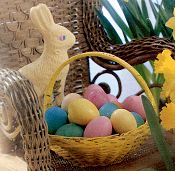Catholic Activity: Activities for Easter

After 40 days of penance and preparation, we have finally reached our goal. Now is the time for rejoicing. This is a day for family dinner and activities, to practice many already established traditions and to share the joy together with family and friends. The best of everything should be used today: flowers, china, silver and foods. There should be no holding back in the rejoicing!
DIRECTIONS
Easter Egg Hunt After all the egg decorating, it is fun to search for Easter eggs, outdoors if possible. Incorporate a new tradition of adding a special Alleluia Egg or golden egg (see Holy Saturday Activities). The person who finds this egg wins a special prize, or gets to perform a special coveted task.
Easter Baskets Easter baskets are an American tradition, full of chocolate bunnies and eggs, jelly beans and marshmallow candies. Originally the Easter baskets were a way to celebrate the end of Lenten penance. All foods that were forbidden during Lent are placed in the basket and blessed: cheese, butter, eggs, meats and sweets. For those that are sugar conscious, the baskets can also include little toys, books, flowers, religious holycards with pictures of the resurrection, and a few Easter eggs. There should be reminders that this is the feast of the resurrection, and not just a day to "pig out."
Blessing of the Family Table "The Easter liturgy is permeated by a sense of newness: nature has been renewed, since Easter coincides with Spring in the Northern hemisphere; fire and water have been renewed; Christian hearts have been renewed through the Sacrament of Penance, and, where possible, through administration of the Sacraments of Christian initiation; the Eucharist is renewed, so to speak: these are signs and sign-realities of the new life begun by Christ in the resurrection.
Among the pious exercises connected with Easter Sunday, mention must be made of the traditional blessing of eggs, the symbol of life, and the blessing of the family table; this latter, which is a daily habit in many Christian families that should be encouraged, is particularly important on Easter Sunday: the head of the household or some other member of the household, blesses the festive meal with Easter water which is brought by the faithful from the Easter Vigil. — Directory on Popular Piety and the Liturgy
In addition, in some countries, Easter is associated with the following displays of popular piety:
The Risen Christ meets his Mother
Popular piety intuits a constancy in the relationship between Christ and his mother: in suffering and death and in the joy of the resurrection.Visit to the Mother of the Risen ChristThe liturgical affirmation that God replenished the Blessed Virgin Mary with joy in the resurrection of her Son, has been translated and represented, so to speak, in the pious exercise of the meeting of the Risen Christ with His Mother: on Easter morning two processions, one bearing the image of Our Lady of Dolors, the other that of the Risen Christ, meet each other so as to show that Our Lady was the first, and full participant in the mystery of the Lord's resurrection.
What has already been said in relation to the processions of "the dead Christ" also applies to this pious exercise: the observance of the pious exercise should not acquire greater importance than the liturgical celebration of Easter Sunday nor occasion inappropriate mixing of liturgical expressions with those of popular piety. — Directory on Popular Piety and the Liturgy
At the conclusion of the Easter Vigil, or following the Second Vespers of Easter, a short pious exercise is kept in many places: flowers are blessed and distributed to the faithful as a sign of Easter joy. Some are brought to the image of Our Lady of Dolors, which is then crowned, as the Regina Coeli is sung. The faithful, having associated themselves with the sorrows of the Blessed Virgin in the Lord's Passion and Death, now rejoice with her in His resurrection.While this pious exercise should not be incorporated into the liturgical action, it is completely in harmony with the content of the Paschal Mystery and is a further example of the manner in which popular piety grasps the Blessed Virgin Mary's association with the saving work of her Son." — Directory on Popular Piety and the Liturgy
Activity Source: Original Text (JGM) by Jennifer Gregory Miller, © Copyright 2003-2023 by Jennifer Gregory Miller







